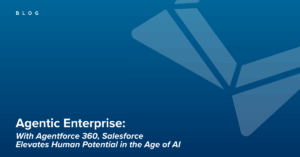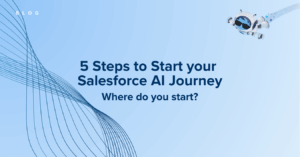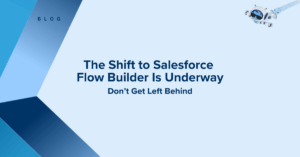Salesforce AI is a game-changer for CRM – automating workflows, sharpening decisions, and delivering standout customer experiences. But let’s be real: jumping straight into AI without a strategy can lead to costly mistakes. With over 80% of AI projects missing their goals, success is about more than just plugging in cool tech. It requires a smart, focused approach that leverages Salesforce’s AI ecosystem; from Einstein AI to Agentforce, while steering clear of the common pitfalls that trip up even experienced teams.
Here’s your go-to guide for adopting Salesforce AI confidently and effectively:
1. Starting With Technology Instead of the Problem
The biggest mistake? Falling for the shiny tech without defining the business problem first. Jumping straight to Agentforce because it sounds exciting won’t cut it.
What works: Identify a real bottleneck first, whether that’s slow case resolution or poor lead scoring. Then pick the AI tool designed to fix that specific pain point. Align your pilot around solving a clear issue, and the impact becomes measurable and meaningful.
2. Choosing the Wrong Type of AI
Salesforce offers a variety of AI tools, each serving a different purpose. Mixing them up can lead to the wrong solution:
- Einstein Bots – Handle scripted customer chats, answering FAQs and guiding users through predefined flows.
- Einstein Prediction Builder – Forecasts trends and outcomes from your CRM data, such as likelihood to close a deal or customer churn risk.
- Einstein Generative AI Prompt Templates – Provide lightweight, single-action AI capabilities (e.g., summarising records, generating emails, or enriching fields). These can be embedded directly into flows for quick wins when a full agent is unnecessary.
- Agentforce – Builds autonomous AI agents that can reason over data, orchestrate tools, and take multi-step actions to achieve business goals. While prompt templates power many simple generative use cases, Agentforce is best for when you need true autonomy and decision-making.
3. Overcomplicating the Pilot
Trying to solve everything at once? That’s a recipe for delays and frustration.
Better approach: Start small and focused. Automate one clear, repeatable task; like lead qualification in a specific region, evaluating case sentiment or scoring cases as spam. This builds quick wins, confidence, and proof of value that make scaling AI easier.
4. Unclear AI Agent Roles and Responsibilities
Without clear instructions, AI agents can make mistakes or frustrate users.
Use Salesforce’s flowbuilder tools to define exactly what your AI agent can and cannot do. Specify task limits, authorisation checks, and communication flows. Clear guardrails ensure consistent, error-free customer experiences.
5. Neglecting Data Quality and Accessibility
You don’t need perfect data to get started.
With Salesforce Data Cloud and integrated CRM data, you can begin working with what you have and improve data quality over time, alongside AI performance.
Real-world example: A manufacturing company improved its sales forecasts even though some customer data was missing, showing that imperfect data can still be valuable.
6. Skipping Guardrails and Ethical Boundaries
AI decisions must be trustworthy and compliant.
Leverage Salesforce Einstein Trust Layer to detect bias and enforce compliance. MuleSoft can help implement these guardrails across internal and external agents by ensuring that connected systems follow the same rules and validations.
Add your own business rules with prompt instructions, validation, and automation. Guardrails keep your AI ethical, transparent, and aligned with company values.
7. Going It Alone Without Expert Support
Even skilled in-house Salesforce teams benefit from expert help when adopting AI.
At iMMERSIVE, we specialise in accelerating AI projects with Einstein AI and Agentforce. Our experience helps you assess where AI can add value and make the biggest impact now in specific use cases, and helps you avoid pitfalls, close deployment gaps, and speed up your time to value.
Partner with experts who truly understand the Salesforce AI ecosystem inside and out.
8. Ignoring the Need for Iteration and Improvement
AI is never “done.” Treating it as a one-time launch sets you up for stagnation.
Build feedback loops using Salesforce’s reporting and monitoring dashboards. Continuously test, tune, and retrain models and AI agents to keep performance sharp and outcomes improving.
9. Measuring the Wrong Metrics
Counting chatbot chats or cases closed? That’s not enough.
Define KPIs tied to real business value: customer satisfaction, revenue growth, reduced manual effort, or lead conversion rates. Use Salesforce Analytics to connect AI activity directly to outcomes that matter.
10. Rushing to Scale Prematurely
Scaling too fast before confirming your pilot’s success can cause chaos.
Test new AI features in Salesforce Sandbox environments first. Roll out gradually, operate change management, train teams properly, and refine processes before going wide. Thoughtful scaling preserves a smooth customer experience and avoids costly missteps.
The Bottom Line
Salesforce AI adoption isn’t magic – it’s a disciplined journey. Define your problem, choose the right tools, start small, keep iterating, and always keep ethics and data quality front and center. By learning from these pitfalls and harnessing Salesforce’s AI ecosystem smartly, your organisation can unlock automation, insights, and customer experiences that fuel real growth.
Avoid Going It Alone – Partner with iMMERSIVE
As an expert Agentforce partner, iMMERSIVE is your trusted guide for smooth AI adoption. From pinpointing the right use cases to implementing pilots, optimising performance, and scaling AI, our expert team ensures your Salesforce AI projects deliver real, measurable impact – faster and with less risk.
Ready to transform your Salesforce AI journey? Let’s connect and get started.





